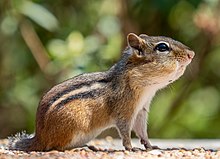| Eastern chipmunk Temporal range:
Early Holocene–present (9,720–0 YBP)[1] | |
|---|---|

| |
| Eastern chipmunk (Tamias striatus) | |
| Scientific classification | |
| Domain: | Eukaryota |
| Kingdom: | Animalia |
| Phylum: | Chordata |
| Class: | Mammalia |
| Order: | Rodentia |
| Family: | Sciuridae |
| Genus: | Tamias |
| Species: | T. striatus
|
| Binomial name | |
| Tamias striatus | |
| Subspecies[4] | |
| |

| |
| Synonyms[5] | |
| |
The eastern chipmunk (Tamias striatus) is a chipmunk species found in eastern North America. It is the only living member of the genus Tamias.[6][7][8][9][10]
- ^ Cite error: The named reference
Graham1983was invoked but never defined (see the help page). - ^ Cassola, F. (2017) [errata version of 2016 assessment]. "Tamias striatus". IUCN Red List of Threatened Species. 2016: e.T42583A115191543. doi:10.2305/IUCN.UK.2016-3.RLTS.T42583A22268905.en.
- ^ Cite error: The named reference
NatureServewas invoked but never defined (see the help page). - ^ Thorington, R.W. Jr; Hoffman, R.S. (2005). "Tamias (Tamias) striatus". In Wilson, D.E.; Reeder, D.M (eds.). Mammal Species of the World: A Taxonomic and Geographic Reference (3rd ed.). Johns Hopkins University Press. p. 817. ISBN 978-0-8018-8221-0. OCLC 62265494.
- ^ "Tamias striatus". Global Biodiversity Information Facility. Retrieved 30 April 2022.
- ^ Patterson, Bruce D.; Norris, Ryan W. (2016). "Towards a uniform nomenclature for ground squirrels: the status of the Holarctic chipmunks" (PDF). Mammalia. 80 (3): 241–251. doi:10.1515/mammalia-2015-0004. S2CID 9955150. Retrieved 8 June 2019.
- ^ Wilson, D. E.; D. M. Reeder (2005). "Mammal Species of the World". Archived from the original on 23 June 2007. Retrieved 27 June 2007.
- ^ Piaggio, A. J.; Spicer, G. S. (2001). "Molecular phylogeny of the chipmunks inferred from mitochondrial cytochrome b and cytochrome oxidase II gene sequences" (PDF). Molecular Phylogenetics and Evolution. 20 (3): 335–350. CiteSeerX 10.1.1.330.9046. doi:10.1006/mpev.2001.0975. PMID 11527462.
- ^ Piaggio, Antoinette J.; Spicer, Greg S. (2000). "Molecular Phylogeny of the Chipmunk Genus Tamias Based on the Mitochondrial Cytochrome Oxidase Subunit II Gene" (PDF). Journal of Mammalian Evolution. 7 (3): 147–166. doi:10.1023/a:1009484302799. S2CID 7623018.
- ^ Musser, G. G.; Durden, L. A.; Holden, M. E.; Light, J. E. (2010). "Systematic review of endemic Sulawesi squirrels (Rodentia, Sciuridae), with descriptions of new species of associated sucking lice (Insecta, Anoplura), and phylogenetic and zoogeographic assessments of sciurid lice" (PDF). Bulletin of the American Museum of Natural History. 339 (339): 1–260. doi:10.1206/695.1. hdl:2246/6067. S2CID 82712592.

